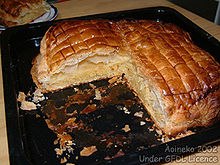Galette des Rois
The Galette des Rois is the variant of the Epiphany cake that is widespread in France , Belgium , Luxembourg and the Saarland . It is served on January 6th, Epiphany, in memory of the three wise men.
The history of the Galette des Rois has two origins: first of all, the Roman Saturn Week, a 7-day festival during which the children were usually given cakes. The date coincided with the time of the feudal duties, and the cake was therefore given the name "King Cake". The second origin goes back to the Concordat of 1801 , which set January 6th as the date for the Feast of Epiphany ( Feast of Apparitions / Three Wise Men). The Feast of Epiphany commemorates the visit of the three kings Caspar , Melchior and Balthasar , who came to bring the baby Jesus the gifts of myrrh , frankincense and gold . The three wise men found their way to the manger in Bethlehem by following the star that showed them the way.
Today's tradition of sharing a “King's Day Galette” is due to this dual origin. It is customary to the Galette a Fève called (broad bean) small ( porcelain -) Figure einzubacken. Anyone who finds the figure (or the bean) in their piece of cake is crowned with a cardboard crown and is king for a day. He can choose his queen, who can also put on a crown. Whenever the king raises his glass to his mouth, all family members have to shout out “Le roi boit” (The King drinks), a combination of words that is difficult for the French to pronounce. This custom is mainly cultivated in families with children and in kindergartens.
In some families, the "poor piece" or the "love God piece" is put aside to give to unforeseen visitors.
There are basically two types of “galette des rois”, la brioche ( yeast dough ) and galette feuilletée ( puff pastry ).
La brioche
In the south of France the king cake is made from brioche dough, a yeast dough with a high fat content, either as brioche plain, very simple, in the form of a large wheel with sugar sprinkles or, especially in Provence, filled with candied fruit. This southern French variant, known as couronne des rois ("royal wreath") or gâteau des rois ("king's cake"), is very similar to the Catalan tortell des rice and the Spanish roscón de Reyes .
Galette feuilletée
The puff pastry galette is particularly common in northern France. The round shape of the flat cake symbolizes the sun. The golden color is like the light. The puffy dough is the book of wisdom and the figurine is wisdom.
There are different versions, the “dry” galette ( galette sèche ) made from puff pastry with only sugar and the galette made from puff pastry with almond cream ( frangipane ), named after a Marchese Muzio Frangipani.
Fèves
Instead of dried beans, a wide variety of porcelain figurines are baked into the galette.
Individual evidence
- ↑ As is customary with anecdotal accounts of culinary inventions, the most contradicting details are given in the literature. What all variants have in common is that the Italian Marchese Muzio Frangipani is said to have lived in Paris in the 16th century and invented a scent for perfuming gloves that smelled of red frangipani (red jasmine), which is why the plant, the scent and also the ( Almond cream that smells similar or has its scent in earlier recipes) were named after him.
Web links
- the custom: the "galette des rois" in the carom broadcast on January 4, 2004
- Project 1: We bake a “galette des rois”. School project document of the Institut français




















